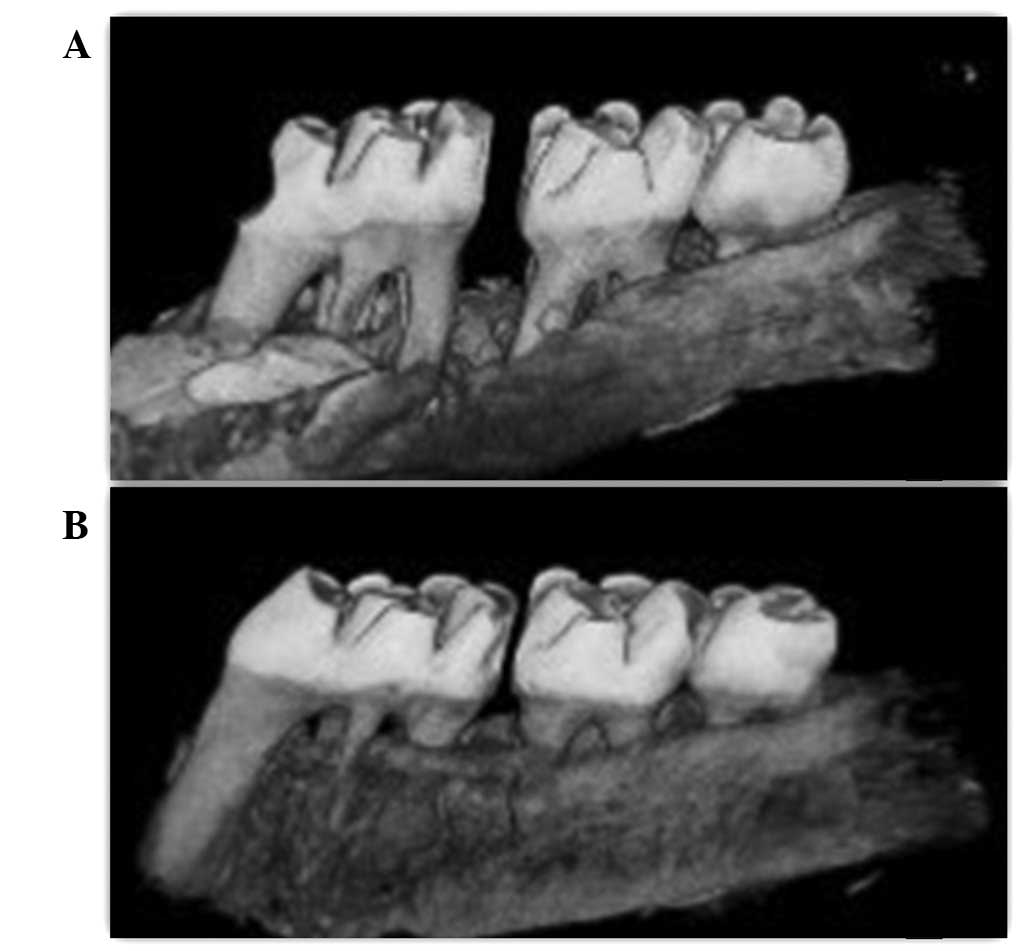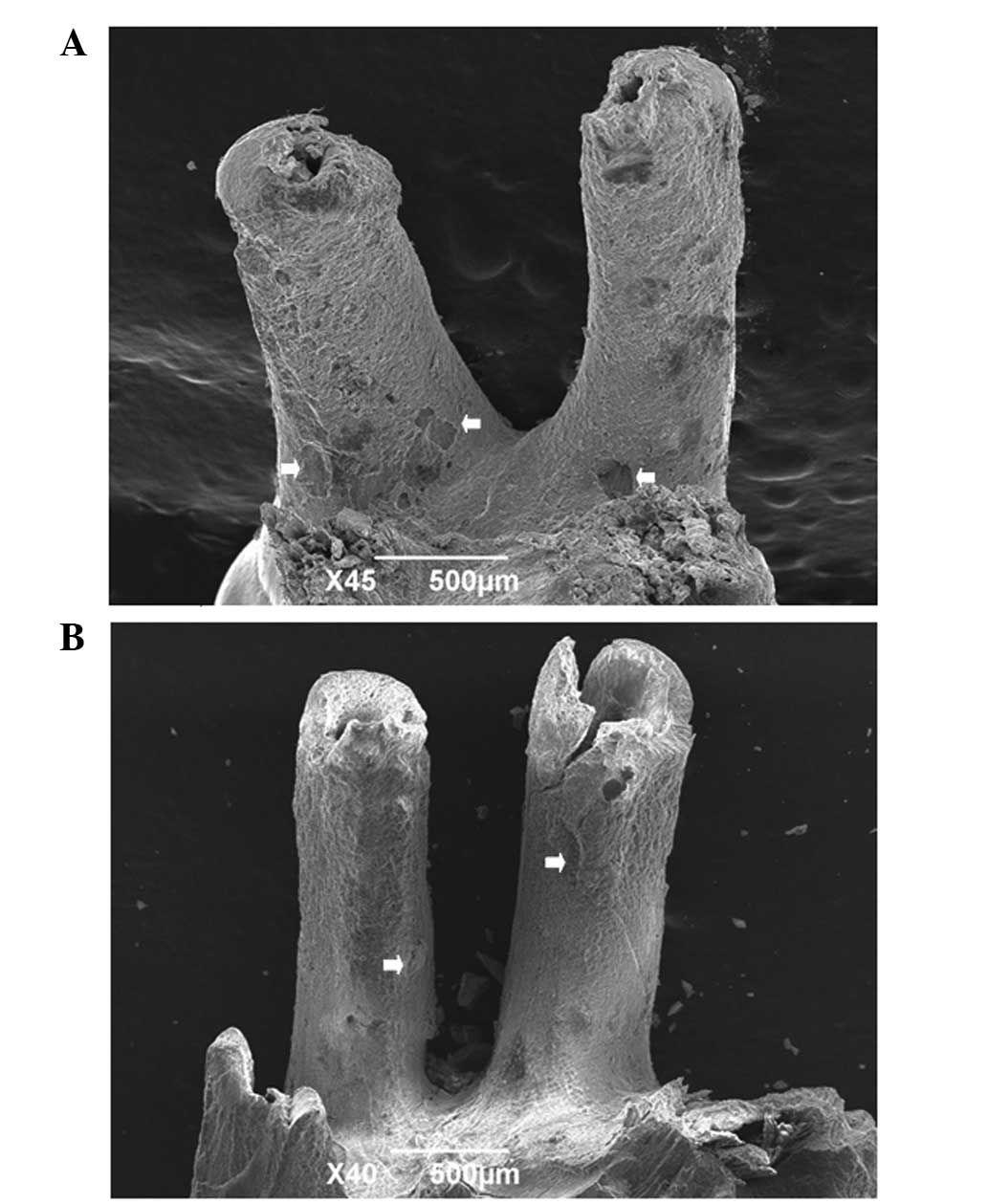|
1
|
Reitan K: Biomechanical principles and
reactions. Current Orthodontic Concepts and Techniques. 4th
edition. Graber TM and Swain BF: Elsevier Inc; St Louis, MO: pp.
145–219. 2005
|
|
2
|
Diravidamani K, Sivalingam SK and Agarwal
V: Drugs influencing orthodontic tooth movement: An overall review.
J Pharm Bioallied Sci. 4:S299–S303. 2012. View Article : Google Scholar : PubMed/NCBI
|
|
3
|
Tanaka Y, Nakayamada S and Okada Y:
Osteoblasts and osteoclasts in bone remodeling and inflammation.
Curr Drug Targets Inflamm Allergy. 4:325–328. 2005. View Article : Google Scholar : PubMed/NCBI
|
|
4
|
Domon S, Shimokawa H, Matsumoto Y,
Yamaguchi S and Soma K: In situ hybridization for matrix
metalloproteinase-1 and cathepsin K in rat root-resorbing tissue
induced by tooth movement. Arch Oral Biol. 44:907–915. 1999.
View Article : Google Scholar : PubMed/NCBI
|
|
5
|
Sprogar S, Vaupotic T, Cör A, Drevensek M
and Drevensek G: The endothelin system mediates bone modeling in
the late stage of orthodontic tooth movement in rats. Bone.
43:740–747. 2008. View Article : Google Scholar : PubMed/NCBI
|
|
6
|
Harry MR and Sims MR: Root resorption in
bicuspid intrusion. A scanning electron microscope study. Angle
Orthod. 52:235–258. 1982.PubMed/NCBI
|
|
7
|
Stevnik A and Mjör IA: Pulp and dentine
reactions to experimental tooth intrusion. A histological study of
the initial changes. Am J Orthod. 57:370–385. 1970. View Article : Google Scholar
|
|
8
|
Liu Z, Xu J, EL and Wang D: Ultrasound
enhances the healing of orthodontically induced root resorption in
rats. Angle Orthod. 82:48–55. 2012. View Article : Google Scholar : PubMed/NCBI
|
|
9
|
Bosshardt DD, Masseredjian V and Nanci A:
Root resorption and tissue repair in orthodontically treated human
premolars. Biological Mechanisms of Tooth Eruption, Resorption and
Replacement by Implants. Davidovitch Z and Mah J: Harvard Society
for the Advancement of Orthodontics; Boston, MA: pp. 425–437.
1998
|
|
10
|
Brudvik P and Rygh P: The initial phase of
orthodontic root resorption incident to local compression of the
periodontal ligament. Eur J Orthod. 15:249–263. 1993. View Article : Google Scholar : PubMed/NCBI
|
|
11
|
Brudvik P and Rygh P: Transition and
determinants of orthodontic root resorption-repair sequence. Eur J
Orthod. 17:177–188. 1995. View Article : Google Scholar : PubMed/NCBI
|
|
12
|
Hughes B and King GJ: Effect of
orthodontic appliance reactivation during the period of peak
expansion in the osteoclast population. Anat Rec. 251:80–86. 1998.
View Article : Google Scholar : PubMed/NCBI
|
|
13
|
Zhou D, Hughes B and King GJ:
Histomorphometric and biochemical study of osteoclasts at
orthodontic compression sites in the rat during indomethacin
inhibition. Arch Oral Biol. 42:717–726. 1997. View Article : Google Scholar
|
|
14
|
Roberts WE, Turley PK, Brezniak N and
Fiedler PJ: Bone physiology and metabolism. CDA J. 15:54–61.
1987.
|
|
15
|
Lindskog S, Blomlöf L and Hammarström L:
Dentin resorption in replanted monkey incisors. Morphology of
dentinoclast spreading in vivo. J Clin Periodontol. 15:365–370.
1988. View Article : Google Scholar : PubMed/NCBI
|
|
16
|
Sismanidou C, Hilliges M and Lindskog S:
Healing of the root surface-associated periodontium: an
immunohistochemical study of orthodontic root resorption in man.
Eur J Orthod. 18:435–444. 1996. View Article : Google Scholar : PubMed/NCBI
|
|
17
|
Olsen BR, Reginato AM and Wang W: Bone
development. Annu Rev Cell Dev Biol. 16:191–220. 2000. View Article : Google Scholar
|
|
18
|
Hedgepeth CM, Conrad LJ, Zhang J, Huang
HC, Lee VM and Klein PS: Activation of the Wnt signaling pathway: a
molecular mechanism for lithium action. Dev Biol. 185:82–91. 1997.
View Article : Google Scholar : PubMed/NCBI
|
|
19
|
Klein PS and Melton DA: A molecular
mechanism for the effect of lithium on development. Proc Natl Acad
Sci USA. 93:8455–8459. 1996. View Article : Google Scholar : PubMed/NCBI
|
|
20
|
O’Brien WT, Harper AD, Jové F, Woodgett
JR, Maretto S, Piccolo S and Klein PS: Glycogen synthase
kinase-3beta haploinsufficiency mimics the behavioral and molecular
effects of lithium. J Neurosci. 24:6791–6798. 2004.PubMed/NCBI
|
|
21
|
Clément-Lacroix P, Ai M, Morvan F,
Roman-Roman S, Vayssière B, Belleville C, Estrera K, Warman ML,
Baron R and Rawadi G: Lrp5-independent activation of Wnt signaling
by lithium chloride increases bone formation and bone mass in mice.
Proc Natl Acad Sci USA. 102:17406–17411. 2005.PubMed/NCBI
|
|
22
|
Logan CY and Nusse R: The Wnt signaling
pathway in development and disease. Annu Rev Cell Dev Biol.
20:781–810. 2004. View Article : Google Scholar : PubMed/NCBI
|
|
23
|
Holmen SL, Zylstra CR, Mukherjee A, Sigler
RE, Faugere MC, Bouxsein ML, Deng L, Clemens TL and Williams BO:
Essential role of beta-catenin in postnatal bone acquisition. J
Biol Chem. 280:21162–21168. 2005. View Article : Google Scholar : PubMed/NCBI
|
|
24
|
Hill TP, Später D, Taketo MM, Birchmeier W
and Hartmann C: Canonical Wnt/beta-catenin signaling prevents
osteoblasts from differentiating into chondrocytes. Dev Cell.
8:727–738. 2005. View Article : Google Scholar : PubMed/NCBI
|
|
25
|
Day TF, Guo X, Garrett-Beal L and Yang Y:
Wnt/beta-catenin signaling in mesenchymal progenitors controls
osteoblast and chondrocyte differentiation during vertebrate
skeletogenesis. Dev Cell. 8:739–750. 2005. View Article : Google Scholar
|
|
26
|
Glass DA II, Bialek P, Ahn JD, Starbuck M,
Patel MS, Clevers H, Taketo MM, Long F, McMahon AP, Lang RA and
Karsenty G: Canonical Wnt signaling in differentiated osteoblasts
controls osteoclast differentiation. Dev Cell. 8:751–764. 2005.
View Article : Google Scholar : PubMed/NCBI
|
|
27
|
Nemoto E, Koshikawa Y, Kanaya S, Tsuchiya
M, Tamura M, Somerman MJ and Shimauchi H: Wnt signaling inhibits
cementoblast differentiation and promotes proliferation. Bone.
44:805–812. 2009. View Article : Google Scholar : PubMed/NCBI
|
|
28
|
Schou M: Lithium treatment at 52. J Affect
Disord. 67:21–32. 2001. View Article : Google Scholar
|
|
29
|
Krishnan V, Bryant HU and MacDougald OA:
Regulation of bone mass by Wnt signaling. J Clin Invest.
116:1202–1209. 2006. View
Article : Google Scholar : PubMed/NCBI
|
|
30
|
Reitan K: Clinical and histologic
observations on tooth movement during and after orthodontic
treatment. Am J Orthod. 53:721–745. 1967. View Article : Google Scholar : PubMed/NCBI
|
|
31
|
Rygh P: Ultrastructural changes in tension
zones of rat molar periodontium incident to orthodontic tooth
movement. Am J Orthod. 70:269–281. 1976. View Article : Google Scholar : PubMed/NCBI
|
|
32
|
Yoshimatsu M, Kitaura H, Fujimura Y,
Kohara H, Morita Y, Eguchi T and Yoshida N: Inhibitory effects of
IL-12 on experimental tooth movement and root resorption in mice.
Arch Oral Biol. 57:36–43. 2012. View Article : Google Scholar : PubMed/NCBI
|
|
33
|
Dolce C, Vakani A, Archer L, Morris-Wiman
JA and Holliday LS: Effects of echistatin and an RGD peptide on
orthodontic tooth movement. J Dent Res. 82:682–686. 2003.
View Article : Google Scholar : PubMed/NCBI
|
|
34
|
Alakus Sabuncuoglu F and Esenlik E:
Influence of drugs on orthodontic tooth movement. Pakistan Oral
Dent J. 30:398–401. 2010.
|
|
35
|
Sandy JR and Harris M: Prostaglandins and
tooth movement. Eur J Orthod. 6:175–182. 1984. View Article : Google Scholar : PubMed/NCBI
|
|
36
|
Kehoe MJ, Cohen SM, Zarrinnia K and Cowan
A: The effect of acetaminophen, ibuprofen and misoprostol on
prostaglandin E2 synthesis and the degree and rate of orthodontic
tooth movement. Angle Orthod. 66:339–349. 1996.PubMed/NCBI
|
|
37
|
Talic NF, Evans C and Zaki AM: Inhibition
of orthodontically induced root resorption with echistatin, an
RGD-containing peptide. Am J Orthod Dentofacial Orthop.
129:252–260. 2006. View Article : Google Scholar : PubMed/NCBI
|
|
38
|
Verma C, Hartig LE, Kalia S and Melsen B:
Influence of steroid drugs on orthodontically induced root
resorption. Orthod Craniofac Res. 9:57–62. 2006. View Article : Google Scholar : PubMed/NCBI
|
|
39
|
Nase JB and Suzuk JB: Osteonecrosis of the
jaw and oral bisphosphonate treatment. J Am Dent Assoc.
137:1115–1119. 2006. View Article : Google Scholar : PubMed/NCBI
|
|
40
|
Frith JC, Mönkkönen J, Auriola S,
Mönkkönen H and Rogers MJ: The molecular mechanism of action of the
antiresorptive and antiinflammatory drug clodronate: evidence for
the formation in vivo of a metabolite that inhibits bone resorption
and causes osteoclast and macrophage apoptosis. Arthritis Rheum.
44:2201–2210. 2001. View Article : Google Scholar
|
|
41
|
Adachi H, Igarashi K, Mitani H and Shinoda
H: Effects of topical administration of a bisphosphonate
(risedronate) on orthodontic tooth movements in rats. J Dent Res.
73:1478–1486. 1994.PubMed/NCBI
|
|
42
|
Igarashi K, Mitani H, Adachi H and Shinoda
H: Anchorage and retentive effects of a bisphosphonate (AHBuBP) on
tooth movements in rats. Am J Orthod. 106:279–289. 1994. View Article : Google Scholar : PubMed/NCBI
|

















